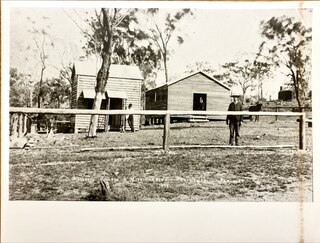
Biggenden is a rural town and locality in the North Burnett Region, Queensland, Australia. In the 2016 census, Biggenden had a population of 845 people.

The Shire of Biggenden was a local government area located in the northern catchment of the Burnett River, Queensland, Australia, 100 kilometres (62 mi) south-southwest of the regional city of Bundaberg. The shire covered an area of 1,314.5 square kilometres (507.5 sq mi), and existed as a local government area from 1905 until 2008, when it amalgamated with several other shires to become the North Burnett Region.

Paradise is a town on the Burnett River, in Queensland, Australia, within the present-day locality of Coringa in the North Burnett Region. It no longer exists.

Degilbo is a rural town and locality in the North Burnett Region, Queensland, Australia. In the 2016 census, the locality of Degilbo had a population of 174 people.

Ideraway is a rural town and locality in the North Burnett Region, Queensland, Australia. In the 2016 census, the locality of Ideraway had a population of 38 people.

Coalstoun Lakes is a rural town and locality in the North Burnett Region, Queensland, Australia. In the 2016 census, the locality of Coalstoun Lakes had a population of 114 people.

Abercorn is a rural town and locality in the North Burnett Region, Queensland, Australia. In the 2016 census, the locality of Abercorn had a population of 46 people.

Didcot is a rural locality in the North Burnett Region, Queensland, Australia. In the 2016 census Didcot had a population of 60 people.
Gordonbrook is a rural locality in the South Burnett Region, Queensland, Australia. In the 2016 census Gordonbrook had a population of 175 people.
Boondooma is a rural locality in the South Burnett Region, Queensland, Australia. In the 2016 census, Boondooma had a population of 76 people.
Cynthia is a rural town and locality in the North Burnett Region, Queensland, Australia. In the 2016 census, Cynthia had a population of 31 people.
Dallarnil is a rural town and locality in the North Burnett Region, Queensland, Australia. In the 2016 census, Dallarnil had a population of 230 people. The neighbourhood of Stanton is within the locality.

Kalpowar is a town in the North Burnett Region and a locality split between the North Burnett Region and the Bundaberg Region, in Queensland, Australia. In the 2016 census, the locality of Kalpowar had a population of 67 people.

Bancroft is a rural locality in the North Burnett Region, Queensland, Australia. In the 2016 census, Bancroft had a population of 96 people.
Kapaldo is a rural town and locality in the North Burnett Region, Queensland, Australia. In the 2016 census, the locality of Kapaldo had a population of 43 people.
Moonford is a rural town and locality in the North Burnett Region, Queensland, Australia. In the 2016 census, the locality of Moonford had a population of 160 people.
Mount Steadman is a rural locality in the North Burnett Region, Queensland, Australia. In the 2016 census Mount Steadman had a population of 8 people.
Ban Ban is a rural locality in the North Burnett Region, Queensland, Australia. In the 2016 census, Ban Ban had a population of 34 people.
Golden Fleece is a locality in the North Burnett Region, Queensland, Australia. In the 2016 census, Golden Fleece had a population of 49 people.
Woowoonga is a locality in the North Burnett Region, Queensland, Australia. In the 2016 census, Woowoonga had a population of 92 people.










